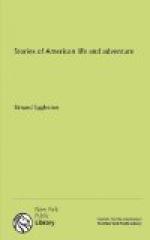“All right,” said Mrs. Craig. “Put the baby on with the children. This horse is slow, and I will ride on. You can bring the other horses, and catch up with me soon.”
By the time the second horse was loaded, and George and Betsey were stowed away in their baskets, both the father and Betsey had forgotten about the baby. The mother had got so far ahead that it took the other horses nearly an hour to overtake her’s.
“Where is the baby?” cried the mother when she looked back and saw but two children on the horse behind.
Sure enough, where was the baby? Lying under a tree top in the lonesome woods, where there might be fierce wolves, great panthers, or hungry wildcats.
Mr. Craig was almost frantic when he thought of the baby’s danger. He stripped the things from the middle horse, and sprang on his back, gun in hand. He laid whip to the horse, and was soon galloping back over the rough path. For more than an hour the mother and children waited with the hired man, to learn whether the baby had been killed by some wild animal or not.
At last the sound of Mr. Craig’s horse coming back was heard, and all held their breath. As the father came in sight in a full gallop, he shouted, “Here he is, safe and sound! The little rascal hadn’t waked up.”
Mrs. Craig and Betsey shed tears of joy. George turned his face away, and wiped his eyes with his coat sleeve. He wasn’t going to cry: he was a boy.
ELIZABETH ZANE.
On the banks of the Ohio River, near the place where the city of Wheeling now stands, there was once a fort called Fort Henry. This fort was of the kind called a blockhouse, which is a house built of logs made to fit close together. The upper part of the house jutted out beyond the lower, in order that the men in the blockhouse might shoot downwards at the Indians if they should come near the house to set it on fire. Fort Henry was surrounded with a stockade; that is, a fence made by setting posts in the ground close together.
During the Revolutionary War the Indians in the neighborhood of this fort were fighting on the side of the English. A large number of them came to Fort Henry, and tried to take it. All the men that were sent outside of the fort to fight the Indians were either killed, or kept from going back. The women and the children of the village which stood near had all gone into the fort for safety.
When at last the fiercest attack of the Indians was made, there were only twelve men and boys left inside of the fort. These men and boys had made up their minds to do their best to save the lives of the women and children who were with them. Every man and every boy in the fort knew how to shoot a rifle. They had guns enough, but they had very little powder. So they fired only when they were sure of hitting one of the enemy.
The Indians kept shooting all the time. Some of them crept near to the blockhouse, and tried to shoot through the cracks, but the bullets of the men inside brought down these brave warriors.




